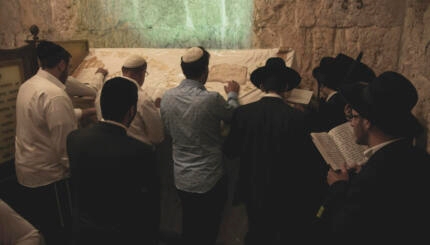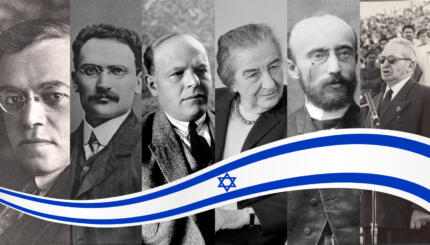Since 1999, Taglit-Birthright Israel has brought more than 500,000 Jewish young adults from around the world to Israel for a free 10-day tour and education program. The initiative is sponsored by the Israeli government along with diaspora Jewish philanthropic foundations, federations and agencies. Motivated by North American Jewish concerns about assimilation, the program is intended to strengthen diaspora Jewish identity and attachments to Israel.
For updated news about Birthright, search for articles about Birthright on JTA and the Cohen Center for Modern Jewish Studies at Brandeis University’s many studies about Birthright.
To apply to go on a free Birthright Israel trip, visit the organization’s website.
Birthright Israel’s History
The use of tourism as a technique of Jewish education and as a means of fostering Jewish connections to the land of Israel dates to the early 20th century, when the Zionist movement began using hiking (tiyul) as a way of introducing Jewish immigrants to their homeland. Soon after Israel gained independence, diaspora Jewish youth movements and the Jewish Agency began drawing on the traditions and infrastructures of tiyul to create educational tours of the country for Jewish adolescents and young adults from around the world.

Help us keep Jewish knowledge accessible to millions of people around the world.
Your donation to My Jewish Learning fuels endless journeys of Jewish discovery. With your help, My Jewish Learning can continue to provide nonstop opportunities for learning, connection and growth.
From the 1960s onward, a stream of evaluation research found that participation in these “Israel experience programs” tended to correlate with stronger Jewish commitments following the trips. Recognition of the power of the trips as a form of experiential Jewish education grew.
By the latter half of the 1980s, a coordinated effort to develop the programs and to make them a North American Jewish funding priority was being spearheaded by the CRB Foundation, a Canadian philanthropy founded by Seagram’s heir, Charles R. Bronfman. At first, the CRB effort focused on marketing and strengthening existing Israel experience programs . These investments succeeded in raising the profile of Israel trips on the Jewish philanthropic scene, but produced no large-scale increase in program participation rates.
In the late 1990s, CRB partnered with another foundation, Michael Steinhardt’s Jewish Life Network (JLN) to reintroduce an idea that had been floated at the beginning of the decade by Israel’s then-Deputy Foreign Minister, Yossi Beilin: Every diaspora Jewish young adult should be presented with the gift of a free trip to Israel. CRB and JLN put up their own funds to realize the idea, gained commitments from other philanthropic foundations, and then proceeded to convince a reluctant Israeli government and an ambivalent Jewish federation system to join as partners in the venture.
Birthright Israel’s Structure
Birthright Israel itself does not run trips. Rather it serves as an umbrella organization that sets program standards and distributes funding to independent tour operators which it licenses as authorized providers of Birthright Israel tours. The providers (different from year to year) represent a variety of religious and political stripes, and often serve niche markets. Among the largest providers have been Hillel, the Jewish college student organization, and (until recently) Oranim, a for-profit company. All groups have their own bus, Israeli guide, driver, and staff members from the sponsoring organization.
Birthright targets Jews ages 18 to 26. The program’s standard itinerary includes tours of Jerusalem’s Western Wall, Yad Vashem Holocaust memorial and Mount Herzl military cemetery; Tel Aviv’s Independence Hall; Masada; and the Golan Heights. It also includes several discussion circles where participants are encouraged to voice feelings and opinions about being Jewish and being in Israel. Visitors have the opportunity to befriend Israelis their own age, through an encounter program (mifgash) that has young Israeli army officers join each bus as co-tourists.
Birthright Controversies
Not surprisingly, Birthright Israel’s high profile, high cost, and high political stakes have made it a lightning rod for controversy. Some debates were resolved early on; others are ongoing.
Among those asked to fund the programs, controversies erupted over the ethics, effectiveness, and opportunity costs associated with such a large investment in the trips. Israeli legislators debated whether tax revenues spent on affluent non-citizens should instead be spent serving Israel’s poor.
Diaspora philanthropists and federation leaders debated whether offering the trips as a free gift would lead college students to treat the program as a free party rather than as an educational experience. Questioning the educational value of tourism (a stigmatized leisure activity), they debated whether money would be better invested in other forms of Jewish education such as day schools and camps.
Proponents of the investment in Birthright argued that there was no guarantee that funds would be forthcoming for these alternatives, and pointed to the research documenting the educational successes of earlier Israel experience programs.
Within broader Jewish circles, debates have also centered on the type of Jewish identity that Birthright Israel is imagined to promote. Some critics have contended that the trips promote a vicarious Jewish identity centered on Israel, rather than on Jewish life in the tourists’ own countries. Others have argued that the trips reinforce a classical Zionist core-periphery model that implicitly devalues Jewish life in diaspora. In my research into Birthright, I found that although the trips encouraged feelings of connection to Israel, they also made the visitors aware of just how “not Israeli” they were. This feeling of not being at home in Israel shapes a relationship to the country that is more complicated than the critiques suggest.
Other Jewish communal debates center on whether the trips do and should frame interfaith marriage as a social problem.
The only debate that has spilled beyond the Jewish community and into broader public discourse has centered, predictably, on the trips’ representations of Middle East politics and especially of the Israeli-Palestinian conflict. Here, three questions dominate: How should the trips represent the conflict? How, in practice, are they actually representing it? What goals should this introduction to Middle East geo-politics serve?
Birthright’s Impact
The creation of Birthright Israel marked a watershed in Jewish philanthropy, when the agenda-setting power long wielded by communally-governed institutions passed visibly into the hands of private foundations.
In launching Birthright, CRB and JLN placed the federations and communal agencies (and the Israeli government) in the position of responding to foundation priorities. Birthright also repositioned the denominational and Zionist youth movements–formerly the main purveyors of Israel experience programs–as small players in a field being reoriented to serve young adults rather than high school students.
Although systemic impacts such as these have been profound, they have not garnered much attention in the conversations about Birthright’s outcomes. Rather, most of the interest concerns effects on the Jewish identities and behaviors of the individuals who visit Israel on the trips.
An ongoing evaluation commissioned by Birthright Israel and conducted by researchers at Brandeis University has found that the program, on average, has strong effects on feelings of attachment to Israel and belonging to the Jewish people, and minor effects on religious practice and Jewish communal involvement. The Brandeis team’s 10-year follow-up reported that Birthright alumni were more likely than comparable non-participants to marry other Jews.
Analysis of average effects does not reveal what happens at the extremes. A minority of participants appears to become deeply engaged in Jewish life following the trip. The exact proportion has not yet been documented, but even if the percentage is relatively small, the absolute numbers can be substantial. With more than 250,000 program alumni, even if only two people per bus of 40 become intensely involved in Jewish life upon return, this 5% still translates to over 12,000 young adults bringing their Jewish passions to Hillels, synagogues, service programs, seminaries, and other communal institutions.
Although intensely engaged alumni are an unrepresentative minority, they are, by virtue of their activism, especially visible to those involved in Jewish communal life. Moreover, they almost certainly number in the thousands, and possibly in the tens of thousands. For these reasons, most communal leaders will likely know–or know of–someone who has been profoundly influenced by the trip.
On one hand, this can result in communal leaders using their anecdotal impressions to over-estimate average trip effects. On the other hand, it suggests that Birthright Israel’s most consequential individual-level impacts may not be its across-the-board effects on the average participant, but rather its concentrated impact on that minority of thousands of young Jews who emerge from the trips inspired to take up leadership roles building Jewish life in the communities where they live.



